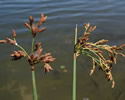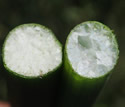Schoenoplectus tabernaemontani (Soft-stem Bulrush)
| Also known as: | Soft-stem Club-rush |
|---|---|
| Genus: | Schoenoplectus |
| Family: | Cyperaceae (Sedge) |
| Life cycle: | perennial |
| Origin: | native |
| Habitat: | sun; wet; lakes, ponds, sloughs, wet ditches, fens, bogs, fresh to brackish marshes |
| Fruiting season: | July - September |
| Plant height: | 2 to 9 feet |
| Wetland Indicator Status: | GP: OBL MW: OBL NCNE: OBL |
| MN county distribution (click map to enlarge): |  |
| National distribution (click map to enlarge): |  |
Pick an image for a larger view. See the glossary for icon descriptions.
Detailed Information
Spikes: 

![[photo of spikelet cluster]](/udata/r9ndp23q/pd3/schoenoplectus-tabernaemontani-072817-9-t.jpg) Open, branching cluster at the top of the stem with 15 to 200 spikelets (flower clusters) mostly single on slender stalks with some in groups of 2 to 4. Spikelets are 3 to 17 mm long (to 2/3 inch), lance-elliptic, pointed at the tip, light to dark orange-brown, with 8 or more florets spirally arranged. Florets are perfect (both male and female parts) each with a 2-parted style and subtended by a single scale. At the base of the cluster is an erect bract 3/8 to 3 inches long that is C-shaped in cross-section and appears to be a continuation of the stem.
Open, branching cluster at the top of the stem with 15 to 200 spikelets (flower clusters) mostly single on slender stalks with some in groups of 2 to 4. Spikelets are 3 to 17 mm long (to 2/3 inch), lance-elliptic, pointed at the tip, light to dark orange-brown, with 8 or more florets spirally arranged. Florets are perfect (both male and female parts) each with a 2-parted style and subtended by a single scale. At the base of the cluster is an erect bract 3/8 to 3 inches long that is C-shaped in cross-section and appears to be a continuation of the stem.
Leaves and stems: 

![[photo of lower stem and leaves]](/udata/r9ndp23q/grass/schoenoplectus-tabernaemontani-26_0720_184019-t.jpg) 3 or 4 leaves are near the base of the stem; only the upper 1 or 2 may have a blade longer than the sheath. Sheaths are deeply V-shaped at the tip, the membranous front splitting and becoming fibrous with age. Stems are erect, round in cross-section, light blue-green when fresh, spongy and easily compressed when gently squeezed. Seen in cross-section, air cavities are up to 2.5 mm in diameter. Plants form colonies from stout rhizomes.
3 or 4 leaves are near the base of the stem; only the upper 1 or 2 may have a blade longer than the sheath. Sheaths are deeply V-shaped at the tip, the membranous front splitting and becoming fibrous with age. Stems are erect, round in cross-section, light blue-green when fresh, spongy and easily compressed when gently squeezed. Seen in cross-section, air cavities are up to 2.5 mm in diameter. Plants form colonies from stout rhizomes.
Fruit: 
![[photo of scales and achenes]](/udata/r9ndp23q/grass/schoenoplectus-tabernaemontani-1-t.jpg) Fruit develops in summer, the mature achenes (seeds) dropping off individually leaving the persistent scales behind.
Scales
are 2 to 3.5 mm long, 1.5 to 2 mm wide, orange-brown with a green or pale midrib, sometimes straw-colored or streaked with red-orange lines, generally egg-shaped, obscurely notched at the tip with a minute straight or bent awn. Scale edges are a bit ragged with contorted hairs.
Achenes
are 1.5 to 2.8 mm long, 1.2 to 1.7 mm wide, flat on the back and rounded on the front (plano-convex), urn-shaped to nearly round in outline, gray-brown and smooth. Surrounding the base are 6 barbed, light brown bristles that are all about the same length and about as long as the achene.
Fruit develops in summer, the mature achenes (seeds) dropping off individually leaving the persistent scales behind.
Scales
are 2 to 3.5 mm long, 1.5 to 2 mm wide, orange-brown with a green or pale midrib, sometimes straw-colored or streaked with red-orange lines, generally egg-shaped, obscurely notched at the tip with a minute straight or bent awn. Scale edges are a bit ragged with contorted hairs.
Achenes
are 1.5 to 2.8 mm long, 1.2 to 1.7 mm wide, flat on the back and rounded on the front (plano-convex), urn-shaped to nearly round in outline, gray-brown and smooth. Surrounding the base are 6 barbed, light brown bristles that are all about the same length and about as long as the achene.
Notes:
Schoenoplectus tabernaemontani, formerly Scirpus validus, is a common wetland species, often found in standing water up to 3 feet deep along lake and pond margins, and may form dense stands. It closely resembles two other Minnesota Schoenoplectus species: Schoenoplectus heterochaetus and Schoenoplectus acutus. All share the common traits of a round stem, not much for leaves, and a terminal cluster with an erect bract that appears to be a continuation of the stem. S. tabernaemontani is distinguished by a spongy stem that is easily compressed when gently squeezed, the stiffly stalked spikelet cluster with up to 200 spikelets, most spikelets single with others grouped 2 to 4, florets with 2-parted styles, plano-convex achenes with (usually) 6 bristles all about the same length and about as long as the achene. Of the 3, it is the most common in MN, has the largest total number of spikelets and is the only one with a spongy stem. Stems are somewhat plastic but may be easily bent by a strong wind or critters. Once bent, that's the end.
By comparison, S. heterochaetus has spikelets that are almost always all single, occasionally paired, florets with 3-parted styles, achenes that are more distinctly 3-sided with 4 bristles, 2 of which are usually much reduced in size. S. acutus spikelets are in groups of 2 to 8 with some singles, scales are usually distinctly red-spotted, and the stem is a darker olive green. S. tabernaemontani hybridizes with both and intermediates may be found when both parents are present. Good luck with those!
Compare these with other Bulrush species, which may differ by their 3-sided stems, spreading leaf-like bracts, leafier stems, globular clusters of numerous small spikelets, or other traits not as above.
Native Plant Nurseries, Restoration and Landscaping Services ↓
More photos
 Schoenoplectus tabernaemontani plants
Schoenoplectus tabernaemontani plants Schoenoplectus tabernaemontani plants
Schoenoplectus tabernaemontani plants a small stand of Schoenoplectus tabernaemontani
a small stand of Schoenoplectus tabernaemontani a dense stand of Schoenoplectus tabernaemontani
a dense stand of Schoenoplectus tabernaemontani stems are easily compressed and bent
stems are easily compressed and bent spikelets are single or grouped 2 to 4
spikelets are single or grouped 2 to 4 flowering spikelets
flowering spikelets more spikelets
more spikelets Schoenoplectus tabernaemontani with S. acutus
Schoenoplectus tabernaemontani with S. acutus comparison of Schoenoplectus tabernaemontani and S. acutus stems
comparison of Schoenoplectus tabernaemontani and S. acutus stems
Photos by K. Chayka taken in Ramsey and Pope counties. Photos courtesy Peter M. Dziuk taken in Pope and Winona counties. Photos courtesy Steve Eggers taken in Dakota County and in Wisconsin.
Comments
Have you seen this plant in Minnesota, or have any other comments about it?






